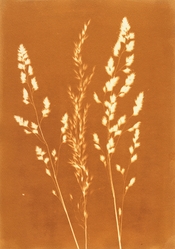Jan de Jong
Subscriber
Trying to find a new process using used hypo-fixer. This should contain silver and I have been working many experiments to see if i can release that again for some type of VanDyke print. Adding it direct will result in fainter blue.
-> let me know if I have found a new process or if this is something existing under a different name already.
Finally tried following:
- a few ml of used fixer
- add some Copper Sulfate (not much)
- wait till it has reacted (it will become brown or dark)
- add same volume of 25gr/100ml concentration Ferric ammonium citrate (same as used for Cyanotype.
Paint on paper or linen
- let dry for short time
Expose in UV or Sun (about same time as normal cyanotype.
- The paper will have before exposing almost white / light green color
- after 3 minutes it will turn yellow
- after 10-50 minutes it will become coffee with milk color.
Contrast seems to have more gradations (see the middle grass halm)
Development:
- I rinsed it in water with a drop of vinegar (pH of my water is 8 so i have to bring it down slightly)
- Dry.

^any tips or suggestions for further experiments welcome.












 ) on top. There was a strong orange color print-out as it came out of the UV box.
) on top. There was a strong orange color print-out as it came out of the UV box.